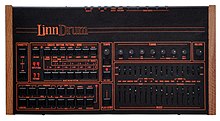
Summary
The LinnDrum, also referred to as the LM-2,[1] is a drum machine manufactured by Linn Electronics between 1982 and 1985. About 5,000 units were sold.[2][3] It was used on many recordings in the 1980s.
| LinnDrum | |
|---|---|
 LinnDrum digital drum machine | |
| Manufacturer | Linn Electronics |
| Dates | 1982–1985 |
| Price | US $2,995 |
| Technical specifications | |
| Polyphony | polyphonic 12 voices |
| Timbrality | multitimbral 15 parts |
| Synthesis type | 8-bit digital samples, 28–35 kHz |
| Storage memory | 56 user patterns, 42 preset drum patterns, 49 songs |
| Effects | Individual level and pan for all sounds, tuning for snare, tom and conga only |
| Input/output | |
| Keyboard | 15 hard plastic "pads" |
| External control | DIN sync (pre-MIDI), third-party MIDI Retrofit Kit, trigger inputs x5 |
Development edit
The LinnDrum was designed by the American engineer Roger Linn.[4] His first drum machine, the Linn LM-1, was released in 1980; it retailed for $5,500,[5] making it affordable only to wealthy musicians and studios.[6] The LinnDrum was cheaper and more widely produced than the LM-1.[4]
Release edit
The LinnDrum was popular for its high-quality samples, flexibility and affordability. It sold far more units than its predecessor (the LM-1) and its successor (the Linn 9000) combined.[3] It was used by artists and producers including Trevor Horn,[7] Stock Aitken Waterman,[8] Haim,[9] Sandy Vee,[10] Justin Hayward,[11] and Michael Jackson.[12] When Linn Electronics closed in 1986, Forat Electronics purchased its assets[13] and offered service, sounds and modifications for the LinnDrum.[14]
References edit
- ^ French, Josh (15 March 2019). "An introduction to the Linn LM-1 and 10 records it helped define". The Vinyl Factory. Archived from the original on 24 June 2021. Retrieved 20 June 2021.
The models also had some teething issues, but those were addressed with two revisions of the LM-1, before a cheaper successor, the LinnDrum – not the LM-2, as it is commonly mis-titled – was introduced in 1982.
- ^ "Linn Electronics LinnDrum". Vintage Synth Explorer. Archived from the original on 16 March 2015. Retrieved 6 March 2015.
- ^ a b "Past Products Museum". Roger Linn Design. Archived from the original on 6 February 2015. Retrieved 7 March 2015.
- ^ a b French, Josh (2019-03-15). "An introduction to the Linn LM-1 and 10 records it helped define". The Vinyl Factory. Archived from the original on 2022-01-29. Retrieved 2022-04-24.
- ^ McNamee, David (2009-06-22). "Hey, what's that sound: Linn LM-1 Drum Computer and the Oberheim DMX". The Guardian. Archived from the original on 2014-12-14. Retrieved 2018-02-09.
- ^ French, Josh (2019-03-15). "An introduction to the Linn LM-1 and 10 records it helped define". The Vinyl Factory. Archived from the original on 2022-01-29. Retrieved 2022-04-24.
- ^ "Classic Tracks: Frankie Goes To Hollywood 'Relax'". Archived from the original on 2023-04-11. Retrieved 2023-07-27.
- ^ "Production Line, Music Technology - Jun 1987". Archived from the original on 2023-07-27. Retrieved 2023-07-27.
- ^ "Haim show you their favourite vintage gear in a studio tour". Archived from the original on 2023-07-27. Retrieved 2023-07-27.
- ^ "Sandy Vee: Recording Katy Perry's 'Firework'". Sound of Sound. April 2011. Archived from the original on April 8, 2024. Retrieved April 8, 2024.
- ^ Justin Hayward talks The Moody Blues, Guitars and New Single "Living For Love" | Interview 2022, archived from the original on 2023-11-14, retrieved 2023-11-14
- ^ "The 5 drum machines that changed music forever". faroutmagazine.co.uk. 2021-08-17. Archived from the original on 2023-07-28. Retrieved 2023-07-28.
- ^ "Forat History". Forat Electronics. Archived from the original on 2023-05-30. Retrieved 2015-03-08.
- ^ "The LinnDrum". Forat Electronics. Archived from the original on 2015-09-24. Retrieved 2015-03-07.
External links edit
- Roger Linn Design


